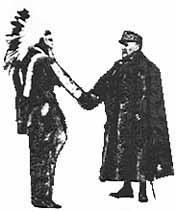


The desire to extirpate the Indian. And the contradictory desire to glorify him. Both are rampant still, to-day."
D.H. Lawrence, 1923. 1
Christopher Columbus's monumental optimism in geographic calculation resulted in the several hundreds of native cultures in America being misperceived, not only misnamed, from the beginning. Whether Arawaks, Totonacs, Tupinambas, Jivaros, Timucuas, Pequots, or Beothuks, these people from the New World would all be categorized as Indios thus eliciting more or less the same expectations from the emigrants from Europe and their successors.
The image of the Indian in the minds of the Whites of 1917 was the result of a complex four-century-long alchemy whose ingredients were reflections, projections, policies toward the Native Americans, pictorial representations, and imaginationthe subject of the following chapter. In considering these elements, more emphasis will be placed on the second part of the analysis, devoted to the various representations of the Indian from 1860 to 1917.
1. Inventing the Indian and Representing Him from the First Encounters to the Civil War
Studying the savage, trying to civilize him, destroying him, in the end they had only studied themselves, strengthened their own civilization.
Roy Harvey Pearce. 2
It is not my purpose here to rewrite the whole story of Indian stereotypes from colonial times to the Civil WarI have neither the ability nor the time to do it and it would stray from the purpose of my study. Nonetheless, the basics of the stereotypes which existed just before the Great War are to be found much earlier in American history. I will thus rapidly review the colonial and early Republic periods up until the 1850s in order to better study the 1860-1917 period.
1.1. From Colonial Times to the 1820s
1.1.1. The Colonial Period 3
In his first voyage, Christopher Columbus saw two categories of Indians, the "peaceful" and the "hostile."4 Amerigo Vespucci, in 1504-05, published further descriptions of the natives he saw in Brazil:
We found in those parts such a multitude of people as nobody could enumerate (as we read in the Apocalypse), a race I say gentle and amenable. All of both sexes go about naked, covering no part of their bodies; and just as they spring from their mother's wombs so they go until death. (...)
The nations wage war upon one another without art or order. The elders by means of certain harangues of theirs bend the youths to their will and inflame them to wars in which they cruelly kill one another, and those whom they bring home captives from war they preserve, not to spare their lives, but that they may be slain for food; for they eat one another, the victors the vanquished, and among other kinds of meat human flesh is a common article of diet with them.5
Vespucci's description of the Indians contains in essence all the stereotypes that would later be developed by Europeans. The "Noble Savage" is here, "gentle and amenable": his going about naked is an Eden-like token of a life lived in harmony with Nature. At the same time, hidden behind this appearance of peacefulness is the other side of the man of the wild, the "Ignoble" Savage. He is warrior-like, not reasonably so in the way of Europeans, but "without art and order," and he is cruel and barbarous, eating the flesh of his enemy as a "common article of diet." At either extreme, the Indian is perceived in terms of the observer's own culture and religion. The peaceful Indian is the reminder of the European's lost Paradise. The cruel Indian is the reminder of the European's Christianizing mission, not to mention his own unacknowledged savagery.
These themes, with their variations and permutations, were the ones developed by the first settlers in North America. For John Smith in 1608 in Virginia, the Powhatan Indians were good as long as they provided free food, but he much less appreciated them in 1613 when they rebelled against this ungratifying status.6 With the expansion of the English colony in New England, New York, Pennsylvania, Maryland, Virginia, and the Carolinas, the Indians soon became mere obstacles to settlement and were thus rapidly associated with Evil, all the more so in New England where the colony was founded on a religious basis.7 Without entering into the details of the different negative images, I should like to note that the French and English colonists quickly saw the interest of forming alliances with Indians in the wars they fought against each other, thus providing the basis for reinforcing the positive image of the Indianat least as far as their Allies were concerned.
By the end of the colonial period, in 1776, all the major themes of the stereotype of the Indians existed. Only one important symbol for our study was lacking and for good reason since it was not yet part of the boundaries of the new nation: the image of the Plains Indian warrior.
1.1.2. The Indian of the Young Republic 8
After the War of Independence, a national American culture would grow and be shared all the more easily with a literacy rate reaching 70 to 75% of the population and the generalization of a commercial network facilitating the circulation of books, magazines, newspapers, almanacs, cartoons, etc.9 The Indian became part of this new cultural context, and his image would consequently be altered.
Even if modified, the dual image of the Indian remained: he was either the noble savage who had fought against English troops, or the brutish one who had resisted, often with the most terrible cruelty, the marvels of American colonization. This dual image appears in different aspects of popular culture. From the 1780s to the 1840s, the success of captivity narratives popularized the image of a barbarous and merciless savage who, on the frontier, was literally crushing the advance of the civilized settlers. At the same time, a "harmless figure" of the Indian was becoming part of the every-day American culture. Cigar-store and weathervane Indians were frozen images that symbolized the death of a reality in the popular mind. Pocahontas, King Philip, or Tecumseh had a happier fate than these objectified figures, since they took their place among the classical heroes America needed, popularized by poems, novels, or dramas.10
Once the new image of the Indian had begun to settle in popular culture, and once the natives were no longer threatening the East Coast populations, the Indian appeared in "high" literature and art. After the triumph of Reason and Classicism in the late 18th century, the first half of the 19th century sought new gods and rushed into Romanticism. And so the Indian became a romantic figure. The romantic period reached its peak in 1855 with Henry Wadsworth Longfellow's poem, The Song of Hiawatha, that was read and appreciated by thousands of people and that offered a romanticized image of Hiawatha, one of the founders of the Iroquois League.11 Meanwhile, James Fenimore Cooper's novels and Catlin's paintings had fed the public's imagination.
Cooper's main source of information on American Indians was the Moravian missionary John Heckewelder so that "his good Indians resemble Christian Delawares and his bad Indians behave like Heckewelder's descriptions of their enemies, the Iroquois."12 The Last of the Mohicans, published in 1826 and Cooper's most famous novel, features the basics of the Leatherstocking series in the general framework of the French and Indian War.
First, there is the white trapper Nathaniel Bumppo, also known as Hawk-eye, or La Longue Carabine, or Kill-deer, or Long Rifle, or Leatherstocking, and who is merely "a Huron under a pale skin."13 Bumppo is "the link between [the Mohicans] and civilized life"he is as cunning as an Indian and as intelligent as a white man.14 Then come the two noble Indians in the persons of Chingachgook and Uncas, Uncas being "the last of the Mohicans," the latter being a division of the Delawares.15 The bad Indian is embodied by Magua, who is a Huron but whose name strangely resembles the term "Maqua" then in use to derogatively call an Iroquoisthe traditional Enemy, according to Cooper.16 At his first appearance as an Indian scout, Magua betrays his dark side"His eye, alone, which glistened like a fiery star amid lowering clouds, was to be seen in its state of native wildness."17 The setting for all Cooper's stories is the frontier, the edge between savagery and civilization. Last but not least, Romanticism impregnates Cooper's stories. Nature, always overwhelming, often foreshadows events to come or reflects the mood of the characters. Following the massacre of Fort William Henry, "the sun had hid its warmth behind an impenetrable mass of vapour, and hundreds of human forms (...) were stiffening in their deformity, before the blasts of a premature November."18 Love stories are marked by tragedy, Cooper respecting the impossibility of miscegenationUncas is not indifferent to Cora, the elder daughter of General Munro, but both the "white maiden" and the "young warrior" die at the hand of the savage Hurons.19
Cooper's novelseleven of which featured Indians20are especially interesting because they contained all the elements that would later contribute towards the immense popular success of the dime novels. On the frontier, the hero incarnated by the white trapperlater the cowboy, or the scout like Buffalo Billfought with good Indians against the bad ones to ensure the progress of civilization. Another contemporaneous contributor to the image of the Indian, this time through their visual representation, was the painter George Catlin.
Carl Bodmer in the 1840s,21 Seth Eastman in the 1830s-1840s,22 and Alfred Jacob Miller in the 1850s-1860s23 were painters who travelled West and depicted American Indians. Yet George Catlin was not only the best known of them but also the one who wrote accounts of his travels, and whose paintings were part of a whole project.
George Catlin, a lawyer before becoming a Philadelphia portrait painter, decided in 1831, at age 35, that he would spend the rest of his life creating a pictorial record of the American Indians. Catlin actually felt he was invested of a task: "Nothing short of the loss of my life shall prevent me from visiting their country, and of becoming their historian"24 and he felt the urgency of his mission:
I started out in the year 1832 (...) inspired with an enthusiastic hope and reliance that I could meet and overcome all the hazards and privations of a life devoted to the production of a literal and graphic delineation of the living manners, customs, and character of an interesting race of people, who are rapidly passing away from the face of the earthlending a hand to a dying nation who have no historians or biographers of their own to portray with fidelity their native looks and history.25
It was thus as a historian that Catlin started on an eight-year series of tours through Indian country in 1832. He not only produced hundreds of portraits and sketches but also collected artefacts from the different tribes he visitedmainly in the Plainswhich enabled him to prepare what he called "Catlin's Indian Gallery." Catlin travelled with his Gallery in cities of the East Coast as early as 1837 and then set out for Europe where he was received by Queen Victoria in England and King Louis-Philippe in France. His Gallery, with "live" Indians and reconstitution of dances and games, can be seen as a forerunner of the late 19th-century Wild West Shows.26
To these people who were "fast travelling to the shades of their fathers"27 and to posterity, Catlin offered the eternal romantic image he had of the American Indians. Outside of the unquestioned artistic quality of his paintingsappreciated by Charles Baudelaire, George Sand and Eugène Delacroix in France 28and particularly through his portrayal of Plains Indian tribes, Catlin contributed a great deal towards creating what would become the visual stereotype of the Noble Indian.
2. Various Images of the Indian: 1860-1917
Rayna Green, in an article published in volume four of the Handbook of North American Indians--"The Indian in Popular American Culture"29--gives numerous examples of the pervading presence of the Indian in the oral, visual, and dramatic manifestations of American popular culture. It would be far too ambitious to give here all the different forms of popular Indian images in the late 19th and early 20th century. I will therefore limit myself to the most obvious images in the United States first, and then in Europe. I shall also voluntarily leave aside all the references to Indians in oral expressions for lack of information on them. Two examples of the latter, however, played an important role in stereotyped newspaper articles during the Great War: the immediate nicknaming of American Indian soldiers as "Chief," and the emphasis on typical Indian-style pidgin English language.30
2.1.1. From the Dime Novels to the First Movies
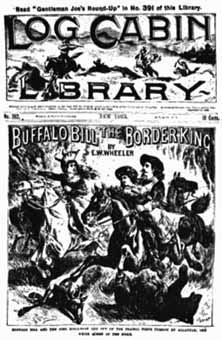 The first dime novel was published
in June 1860 by the Erastus brothers, Irwin Beadle, and Robert
Adams. It was the reedition of a 1839 novel written by Mrs. Ann
S. StephensMaleaka, The Indian Wife of the White Hunter and
it sold 65,000 copies in a few months. In October 1860, Edward
S. Ellis's Seth Jones, or the Captive of the Frontier sold 450,000
copies. In 1864, the leading company in dime novel business, Beadle,
had sold over 5 million books and was quickly copied by other
publishersNorman Munro, Robert de Witt, Street and Smith,
or Frank Tousey. The enormous success of such books did not come
out of the blue. First, these innovative publishers benefited
from the industrialization of the press and used their techniquesprinting
machines and lower postal rates than for booksto flood the
market with books costing between five and ten cents (a dime).
The other key to their success was the adaptation of adventure
storieslike those of Fenimore Cooperto a mass public
by "simplifying [them] and emphasizing the interplay of contrasting
opposites." The western genre constituted three-fourth of
their production until 1880. Dime novels capitalized on a number
of factorsthe attraction of the West for the industrialized
cities of the East, the moral justification of the Conquest through
highly moral characters epitomized in the cowboy first and then
in the scout, and general interest in the last Indian Wars which
were widely reported on in newspapers.31
The first dime novel was published
in June 1860 by the Erastus brothers, Irwin Beadle, and Robert
Adams. It was the reedition of a 1839 novel written by Mrs. Ann
S. StephensMaleaka, The Indian Wife of the White Hunter and
it sold 65,000 copies in a few months. In October 1860, Edward
S. Ellis's Seth Jones, or the Captive of the Frontier sold 450,000
copies. In 1864, the leading company in dime novel business, Beadle,
had sold over 5 million books and was quickly copied by other
publishersNorman Munro, Robert de Witt, Street and Smith,
or Frank Tousey. The enormous success of such books did not come
out of the blue. First, these innovative publishers benefited
from the industrialization of the press and used their techniquesprinting
machines and lower postal rates than for booksto flood the
market with books costing between five and ten cents (a dime).
The other key to their success was the adaptation of adventure
storieslike those of Fenimore Cooperto a mass public
by "simplifying [them] and emphasizing the interplay of contrasting
opposites." The western genre constituted three-fourth of
their production until 1880. Dime novels capitalized on a number
of factorsthe attraction of the West for the industrialized
cities of the East, the moral justification of the Conquest through
highly moral characters epitomized in the cowboy first and then
in the scout, and general interest in the last Indian Wars which
were widely reported on in newspapers.31
One of the best known heroes of the dime novels was Buffalo Bill. In 1869, Street and Smith published the first installment of the first Buffalo Bill story, written by New York Weekly journalist Ned Buntline.32 Buntline had just met the 23-year-old William Frederick Cody, a buffalo hunter, "cow boy, trapper, Pony Express rider, [and] scout in the Army," who became, under Buntline's pen a "living legend": Buffalo Bill. 33 One of the most famous episodes in Cody's life would be his killing of Yellow Hand, a Cheyenne chief (whose real name was Yellow Hair) when scouting for General Crook's army at War Bonnet Creek, Wyoming. Cody claimed it was "his first scalp to avenge Custer."34
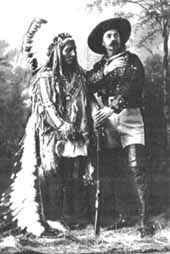 Buffalo Bill's Wild West Show
was launched on May 19, 1883 at the Omaha Fairgrounds, Nebraska.
This was perfect timing since it benefited from the success of
Ned Buntline's dime novels centered around Buffalo Bill, and also
because outdoor shows were becoming very popular. By 1885, 50
circuses were traveling on the roads of the United States, the
most famous of all being P.T. Barnum's Circus, inaugurated in
1843.35 Buffalo Bill's public career had already
begun in 1872, when he began playing in eastern cities in dramas
written by Buntline.36 The Wild West Show was
so successful that it began traveling to England in 1887, to Paris
for the Exposition Universelle and to Spain in 1889, to Italy,
Austria, and Germany in 1890, to Germany again, Holland, Belgium,
and England in 1891. The high point of the Show's career was reached
in 1893 when it participatedalthough outside of the official
perimeterin the Chicago Columbian Exposition.37
The Show continued to travel in Europe until 1905, inspiring popular
authors in England, the Hagenbeck Wild West Show in Germany, and
leaving behind in its wake thousands of elaborate dime show programs
full of Buffalo Bill's exploits, reinforcing in the European minds
the image of the Indian as a Plains Indian warrior.38
Hagenbeck was not the only one to copy the Buffalo Bill Wild West
Show formula: the Pawnee Bill Show, the Sells Floto Circus, the
Miller Brothers' 101 Ranch, etc. All these shows contributed to
the pervasiveness of the stereotype.39
Buffalo Bill's Wild West Show
was launched on May 19, 1883 at the Omaha Fairgrounds, Nebraska.
This was perfect timing since it benefited from the success of
Ned Buntline's dime novels centered around Buffalo Bill, and also
because outdoor shows were becoming very popular. By 1885, 50
circuses were traveling on the roads of the United States, the
most famous of all being P.T. Barnum's Circus, inaugurated in
1843.35 Buffalo Bill's public career had already
begun in 1872, when he began playing in eastern cities in dramas
written by Buntline.36 The Wild West Show was
so successful that it began traveling to England in 1887, to Paris
for the Exposition Universelle and to Spain in 1889, to Italy,
Austria, and Germany in 1890, to Germany again, Holland, Belgium,
and England in 1891. The high point of the Show's career was reached
in 1893 when it participatedalthough outside of the official
perimeterin the Chicago Columbian Exposition.37
The Show continued to travel in Europe until 1905, inspiring popular
authors in England, the Hagenbeck Wild West Show in Germany, and
leaving behind in its wake thousands of elaborate dime show programs
full of Buffalo Bill's exploits, reinforcing in the European minds
the image of the Indian as a Plains Indian warrior.38
Hagenbeck was not the only one to copy the Buffalo Bill Wild West
Show formula: the Pawnee Bill Show, the Sells Floto Circus, the
Miller Brothers' 101 Ranch, etc. All these shows contributed to
the pervasiveness of the stereotype.39
Carlisle-educated Chief Red Fox, who joined Buffalo Bill's Wild West Show as an interpreter in 1893 when he was twenty-three years old explained in his autobiography that "generally, [the Indians'] part in the show was built around ideas Americans entertained about the Indian and his primitive ways of life."40 There could be no better way to explain how stereotyped the Buffalo Bill's Indians were. Famous American Indians like Sitting Bull, or Black Elk, or Standing Bear, 41 and less famous characters spent the whole show shooting arrows, pitching tipis, attacking wagons, or playing the part of the Indians of Custer's Last Standall this in full Plains Indians regalia.42 It did not matter that many of Buffalo Bill's Indians had had an education in off-reservation boarding schools 43: they had been hired to play the primitive and fierce, yet noble, Plains Indian warrior.
It was no wonder that Indian policy-makers did not at all approve of the employment of Indians in Wild West Shows. At a time when the Friends of the Indiansthe Indian Rights Association, the Lake Mohonk Conference, the Board of Indian Commissioners, and the Commissioner of Indian Affairswere doing all they could to Americanize the Indian through education, private property, and citizenship, the Wild West Shows appeared as backward and dangerous. In his 1890 annual report, Commissioner of Indian Affairs Thomas Jefferson Morgan said: "The influence of these shows is antagonistic to that of the schools. The schools elevate, the shows degrade."44 In its 1899 report, the executive committee of the Indian Rights Association commented: "...the shows teach the whites who witness them false ideas about the present condition of the Indians; they represent him only as a savage, and convey no idea of the progress he has made in civilized pursuits."45
The following dialogue as reported by Chief Red Fox between Standing Bear and the Kaiserwho had come to visit the troupe in 1905is interesting when considering what would happen a few years later. Said Standing Bear, offering a peace pipe to the Kaiser: "Indians never go on the warpath against the braves of German tribe." Answered the Kaiser, accepting the pipe: "German soldiers never fight Indiansonly French and English."46
The first contact of American Indians with the moving pictures occurred in 1894 when Edison operators filmed parts of the Buffalo Bill Wild West Showthis first experience set the tone for the next sixty years of the image of the Indian in the film industry. Until the very beginning of the 20th century, all pictures filmed were documentaries, like the Eagle Dance (Edison, 1898), the Parade of the Wild West Show (Edison, 1898), Carlisle School (Biograph, 1902).47
From 1903 on, the "movies" drew audiences essentially composed of "the young and the poor" and thus conformed to the popular art forms of the 19th century. It seems that until 1913, moving pictures offered a relatively wide variety of Indian images. Michael T. Marsden and Jack Nachbar determined three main images of the Indian for this early period: the "Indian Princess", or "Pocahontas," the "Noble Anachronism," and the "Savage Reactionary." After 1913, the "Savage Reactionary" image dominated all western productions.48
David W. Griffith began his carrier with a series of "Indian stories." The ones produced between 1908 and 1910 offer a melodramatic image of the Indian, much in accordance with the humanitarian spirit of the times. The "safely dead Indian" could be depicted as a noble, sentimental, peaceful, and mythical victimthis is what Griffith did in The Redman and the Child (1908), Comata the Sioux (1909), The Mended Lute (1909), The Squaw's Sacrifice (1909), The Heart of a Sioux (1910). Yet, Griffith's victim slowly underwent some changes. In The Massacre (1912), the Indians answered to an attack by the Cavalry by launching a violent attack against the Whites. In The Battle at Elderbush Gulch (1913), Fighting Blood (1911), and The Last Drop of Water (1911) the theme of the bloodthirsty savage became dominant.49
In 1911, when Thomas Harper Ince entered the moving picture industry, he directly specialized in Westerns and, although he featured some romantic IndiansThe Heart of an Indian (1913)he immediately focused on the "Savage Reactionary" image, producing in 1912 the first picture adaptation of Custer's Last Fight.50
In 1913, the first feature-length film was made by Cecil B. DeMille and it was called The Squaw Man. This romantic story, where an Indian woman commits suicide to help her White husband and their child, was so successful that Cecil B. DeMille remade it twice, in 1918 and 1931.51
It thus seems that the images produced by the movie industry in the years preceding the Great War were the result of a relatively new humanitarian concern for the Indian, and the remains of the Frontier days, when the Indian threatened the progress of Civilization. In a period when Native Americans were undergoing terrible hardships in trying to get used to living in confinement, the public closed its eyes on reality in favor of rediscovering the different versions of the Indian of yore. Chief Red Fox, who played secondary roles in westerns as early as 1910, tells about his experience:
I engaged in savage attacks on wagon trains, ambushed White troops, set fire to the homes of White settlers, and lassoed a terrified buffalo calf while galloping on a horse. (...) Those scenes reflected the public's opinion of the Indian and stirred the emotions of audiences. (...) There were times when I wanted to go down to a clean stream and wash away my duplicity, but I had been under the klieg lights a long time, and realized that I could do little to change opinions that were rigidly fixed from the preceding centuries.52
2.1.2. Objects in Wide Circulation
Although paintings by George Catlin or Carl Bodmer contributed towards popularizing the visual image of the Indian, their art was "high" culture and thus of a limited influence. Yet, as Cooper's influence became all the greater when transformed and popularized through dime novels, some works of "high" culture artists also underwent the same process. For example, Benjamin West's 1771 William Penn's Treaty with the Indians inspired many other artists, especially folk painter Edward Hicks' (1780-1849) Peaceable Kingdom series.53 Many of the works of these non-academic artists served as illustrations for calendars and other cheap printed material. Rayna Green gives the example of a very popular painting of Custer's Last Stand distributed by the Anheuser-Busch brewery and hanging in nearly every bar between the late 1870s and 1920.54
In the late 19th century, the paintings and sculptures of Frederic Sackrider Remington (1861-1909) and Charles Marion Russell (1864-1926), nostalgic of the vanishing frontier, consecrated a large share of their works to Plains Indians. Both of their paintings served as illustrations in widely read newspapers such as Harper's, McClures, and Leslie's.55 Finally, in the last years of the 19th century and first decades of the 20th century, more Plains Indian warriors appeared on pedestals in parks and squares than during the previous century.56
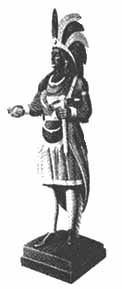 Tobacco-related industries early
played on the image of the Indian as tobacco-giver for both decorative
and advertising purposes. The cigar-store Indians, although in
existence from the 16th century to the 20th century, were particularly
popular between 1850 and 1880. Placed in front of stores selling
tobacco, most of these painted wood figures were large and aggressiveexcept
for female types. Some of these figures were given names of famous
Indian chiefsSitting Bull, Black Hawk, others had comic
namesBig-Chief-Me-Smoke-Em. According to Rayna Green, they
inspired jokes, plays, cartoons, and popular anecdotes, thus becoming
an omnipresent figure in the cultural landscape.57
Many brands of tobacco also used the image of manliness conveyed
by the Indians to ornate and publicize their products.58
Tobacco-related industries early
played on the image of the Indian as tobacco-giver for both decorative
and advertising purposes. The cigar-store Indians, although in
existence from the 16th century to the 20th century, were particularly
popular between 1850 and 1880. Placed in front of stores selling
tobacco, most of these painted wood figures were large and aggressiveexcept
for female types. Some of these figures were given names of famous
Indian chiefsSitting Bull, Black Hawk, others had comic
namesBig-Chief-Me-Smoke-Em. According to Rayna Green, they
inspired jokes, plays, cartoons, and popular anecdotes, thus becoming
an omnipresent figure in the cultural landscape.57
Many brands of tobacco also used the image of manliness conveyed
by the Indians to ornate and publicize their products.58
In 1907, William Haskell Simpson, in charge of the advertising for the Atchinson, Topeka and Santa Fe Railway, created a calendar. Within a few years, this calendar was mailed to thousands of people, decorating kitchens, school walls, and restaurants throughout the United States. The predominant theme of its illustrations was the American Indians, and especially those of the Southwest. The Santa Fe colony of artists working for the Santa Fe Company gave a luminous and peaceful image of their culturesIndians could often be seen squatting around a fire in a warm atmosphere. These were simple and peaceful traditional Indians and this is maybe the reason why this particular popular imagery did not exert much influence on the stereotypes evoked during the Great War.59
Coins, being used by practically everybody in a market economy, can be considered as the popular medium par excellence. In the United States, coins were first officially issued by the newly-created Mint in 1792, the dollar having been chosen by Congress as the basic money unit in July 1785.60 During the colonial period the wampumIndian belts made of shell beadshad first played a non negligible part as a means of exchange between the early settlers and the American Indians. Yet money was soon accepted from foreign traders and, although money was coined by some of the English colonies, the piece of eightor Spanish dollarbecame the standard money unit and even kept in circulation until 1857.61
Issuing money being part of the attributes of a sovereign nation, the motifs used on the coins are important symbols. The first coin issued by the United States Mint was the 1792 disme and it featured on the obverse the profile of a womanpossibly Martha Washingtonwith hair flying in the wind and, on the reverse, a flying eagle. Both figures regularly reappeared on subsequent coins, with modifications but clearly recognizable, the woman figure gradually becoming the image of Liberty.62
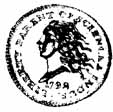 |
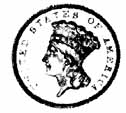 |
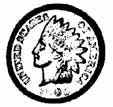 |
The first Indian Head motif was used in 1854 on the obverse of the gold dollar and the $3 gold dollar, designed by James B. Longacre and produced until 1889.63 The traits of the Indian represented were very similar to the classical ones of the Liberty Head designed in 1849 by the same artist. Only the discreet crown of the first one was transformed into a higher feather crown, the result being a noble and feminine figure that had come to symbolize America by this time.
In 1859, the Mint issued an Indian Head penny (one cent), whose designer was once again James B. Longacre and which was produced until 1909, keeping in circulation long after this date.64 The face is not much different from the one Longacre had designed five years earlier but the feather crown is less Mexican-style and more Plains-style. By the end of the 19th century, the Plains Indians had become the symbol of the noble and savage warrior and, even if this coin did not originally represent a Plains Indian, it could well be identified as such and copied as such by soldiers carrying pennies in their pockets during the Great War. If it was necessary to prove the popularity of the penny, director William Wellman did so in his 1944 Buffalo Bill movie, when he had his main character throw a penny in the plate of railroad magnate Vandervere and tell him: "There is only one Indian you know Mr. Vanderverethe Indian on your pennies!"65
The last coin in the series of Indian heads with European features was issued in 1907, until 1933, and was an Eagle ($10). The designer was Augustus Saint-Gaudens and his motif was a head of Liberty crowned by a war bonnet.66 This coin marks an important transitionthe European-like Liberty head was still there but its bonnet was unmistakably a Plains feather bonnet. Yet, this was a $10 coin and thus could not have been in wide circulation.
More important for us was the Quarter Eagle ($2.50) issued in 1907 first because its value made it more accessible than the preceding, but mainly because it was the first coin featuring an Indian head under the feather bonnetand not a European Liberty head. Bela Lyon Pratt designed a true Plains Indian warrior displaying an air of fierce resolution. The same model was used for the Half Eagle ($5) from 1908 to 1929.67 Not even twenty years after the end of the Indian wars, the once fearful Plains Indians were remembered only for the nobility of the cause they had lost, for the Liberty they had demonstrated while defending their territories, their ways of life.
 |
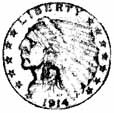 |
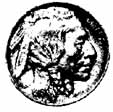 |
In 1913, at the same time as Edward S. Curtis and Joseph K. Dixon were taking pictures of a "vanishing race," James E. Fraser gave his own interpretation of the same theme on the Indian Head nickel (5 cents).68 His declared objective was to "achieve a coin which would be truly America, that could not be confused with the currency of any other country."69 He gave to Iron Tail, one of the three American Indians who served him as a model,70 an air of sad resignation and accompanied him, on the reverse, by another disappearing species: the buffalo. Here we have no feather bonnet, only two drooping feathers. This coin was first officially distributed by the Mint in February 1913 at the groundbreaking ceremony of the Indian Memorial that was to stand in the New York harbor "in memory of a noble, though vanishing race."71 The Wild West Show "101 Ranch," in which Iron Tail was engaged from 1913 to 1916, used his having been a model for an American coin as an official proof of Iron Tail's representativeness as an "Indian chief" in its advertising campaigns.72
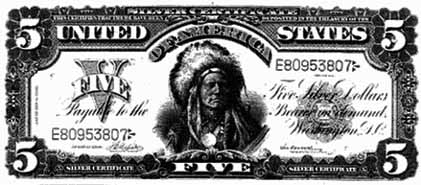
Finally, before leaving the domain of money, where coins were far more popular than bills, we can note that, in 1899, the United States five-dollar silver certificate featured the image of a Plains Indian, foreshadowing that of the 1907 gold Quarter Eagle. The image was the combination of a photograph taken in 1872 by Alexander Gardner of Running Antelope, a Hunkpapa Dakota, and of the photograph of an Indian headdress taken in 1899 by Thomas W. Smillie.73
The following paragraph is based on a study made by Karl Markus Kreis in a 1992 article"'Indians' on Old Picture Postcards."74 The importance of postcards for our study was underlined in the conclusion of Kreis's article: "One can assume that writers, artists, and politicians of the generation before WWI had visited Völkerschauen and Wild West Shows, and that they took home souvenirs in the form of picture postcards," and thus later propagated the images of these postcards in the books they wrote, the paintings, sculptures or photographs they produced, and the discourses they pronounced.
Picture postcards, published since the 1870s, became an "industrial mass product" at the turn of the century and Germany was the worldwide leader of its production until WWI. Although most of the production was in the hands of large businesseslike the Detroit Publishing Company or the Illustrated Postal Card Company, the latter employing 600 employees in 1909, the technical innovations of Eastman Kodak, by which the images could directly be printed from negatives, allowed small publishers to enter the business. Thus, picture postcards became the ideal medium for relating local events, photographic reproductions being still too expensive for newspapers. Postcards also became an advertising tool for promoting such events as the Paris World's Fair of 1889 or the World's Columbian Exposition of 1893 in Chicago. In 1905, around seven billion postcards were mailed around the world, a figure that does not include the enormous share of postcards which were never mailed and went directly into private collections.
The subjects treated on postcards were as numerous as the interests of the public they were trying to appeal to. Indian motifs were thus only one of many others. Since the ultimate goal of postcard producers was to draw profit from massive sales, they essentially tried to satisfy their clients' tastes. In this sense, picture postcards are very useful in evaluating what image the general public held of the Indians at the turn of the century.
Karl Markus Kreis classes Indian motif postcards into three categories: "known persons", "scenes and types," and "popular legends." H.H. Tammen, whose series on Indian chiefs and maidens published in 1909 and 1910 was very successful, often "recycled"and thus popularizedworks of known western artists like Frederic Remington or Charles M. Russell. We have here the same phenomenon as with the dime novels "recycling" famous authors of the first part of the 19th century. Another whole series of Indian chiefs was published as a result of the 1908 Dixon-Wanamaker Expedition to Montana. These chiefs were Plains Indian people and contributed to the spreading of the stereotype of the Indian seen as Plains Indian. Indeed, the series claimed to be "a most colorful study of the North American Indian, a vanishing race," thus offering Indians of a specific culture as the archetype of all other Indians.
"Scenes and types" Indian postcards were often reproductions of photographs taken at "fairs and other displays of peoples." These reconstitutions of scenes that, for most, were part of the pasta tipi with meat drying in the foreground and mountains in the background, for exampleand interestingly represent this ambiguity of North American White people: now that western territories were free for settlement, they could idealize the life of their first inhabitants.
Hiawatha was one of the most foremost themes of the "Popular legends" category, once again representing how a mass medium came to further propagate the already widespread legend as revised by the 1855 poem of Longfellow.
As an advertising tool, postcards were also widely used by the Wild West ShowsBuffalo Bill's and other's. Here again, as most Wild West Show Indians were Plains Indiansor dressed as suchthe stereotype flourished.
The Road to War: Chapter III, continued: 2.1.3 The European's Indian
1. D.H. Lawrence, excerpt from "Studies in Classic American Literature", in The Indian and the White Man. Ed. Wilcomb E. Washburn. Garden City, NY: Doubleday &Company, Inc., 1964, p.453.2. Roy Harvey Pearce. Savagism and Civilization: A Study of the Indian and the American Mind. Revised edition. Berkeley, Los Angeles, London: University of California Press, 1988 (1953), p.xvii.
3. My analysis is mainly based on two books: Robert F. Berkhofer, Jr. The White Man's Indian: Images of the American Indian from Columbus to the Present. New York: Random House, 1978. Roy Harvey Pearce. Savagism and Civilization: A Study of the Indian and the American Mind. Revised edition. Berkeley, Los Angeles, London: University of California Press, 1988 (1953).
4. Robert F. Berkhofer, Jr. "White Conceptions of Indians." In "History of Indian-White Relations." Ed. Wilcomb E. Washburn. Vol. 4. of Handbook of North American Indians. Ed. William C. Sturtevant. Washington, D.C.: Smithsonian Institution, 1988, p.522.
5. Excerpt from Mundus Novus quoted by Robert F. Berkhofer, Jr. The White Man's Indian: Images of the American Indian from Columbus to the Present. New York: Random House, 1978, pp.7-8.
6. Elise Marienstras. La résistance indienne aux Etats-Unis, du XVIe au XXe siècle. Paris: Gallimard/Julliard, 1980, pp.54-58.
7. Roy Harvey Pearce, op. cit., pp.19-35.
8. I am indebted for this paragraph to Elise Marienstras who kindly gave me a copy of a soon-to-be-published paper she presented in March 1992 at the Conference of the Capitol Historical Society. "The Common Man's Indian: The Image of the Indian as a Promoter of National Identity in the Early National Era." Typescript.
11. Roy Harvey Pearce, op. cit., pp.191-94.
12. Robert F. Berkhofer, Jr., op. cit., p.93.
13. James Fenimore Cooper. The Last of the Mohicans. New York: Penguin Books, 1986 (1826), p.280.
16. Ibid., preface to the first edition, p.3.
19. Ibid., Chapter 32 and p.347.
20. Robert F. Berkhofer, Jr., op. cit., p.93.
21. Robert A. Trennert. "Mitchell, David Dawson (1806-1861)." In "History of Indian-White Relations." Ed. Wilcomb E. Washburn. Vol. 4. of Handbook of North American Indians. Ed. William C. Sturtevant. Washington, D.C.: Smithsonian Institution, 1988, p.668.
22. Roy Harvey Pearce, op. cit., p.111.
23. William R. Swagerty. "Indian Trade in the Trans-Mississippi West to 1870." In "History of Indian-White Relations." Ed. Wilcomb E. Washburn. Vol. 4. of Handbook of North American Indians. Ed. William C. Sturtevant. Washington, D.C.: Smithsonian Institution, 1988, pp.372-73.
24. George Catlin. North American Indians. Edited and with an introduction by Peter Matthiessen. New York: Penguin Books, 1989, p.2.
26. Peter Matthiessen's introduction to George Catlin, op. cit., pp.vii-xix. Véronique Wiesinger. "Les 'Sauvages' à Paris au XIXe siècle." ("'Savages' in Paris during the 19th Century"). In Sur le Sentier de la Découverte: Rencontres franco-indiennes du XVIe au XXe siècle. (Crossing Paths: French-Indian Encounters, XVIth to XXth century). Bilingual (French/English) edition. Ed. Véronique Wiesinger, Musée National de la Coopération franco-américaine, Château de Blérancourt. Paris: Réunion des Musées nationaux, 1992, pp.146-49 (English version).
27. George Catlin, op. cit., p.8.
28. See Nelcya Delanoë's beautifully written article: "Dernière rencontre, ou comment Baudelaire, George Sand et Delacroix s'éprirent des Indiens du peintre Catlin." In Destins croisés, Cinq siècles de rencontres avec les Amérindiens. Paris: UNESCO/Albin Michel, 1992, pp.263-81.
29. Rayna Green. "The Indian in Popular American Culture." In "History of Indian-White Relations." Ed. Wilcomb E. Washburn. Vol. 4. of Handbook of North American Indians. Ed. William C. Sturtevant. Washington, D.C.: Smithsonian Institution, 1988, pp.587-606.
31. Alain-Michel Boyer. La Paralittérature. Paris: Que Sais-Je?/Presses Universitaires de France, 1992, pp.86-89.
32. Ralph E. Friar &Natasha A. Friar. The Only Good Indian... The Hollywood Gospel. New York: Drama Book Specialists/Publishers, 1972, p.53. Philippe Jacquin. "Buffalo Bill: de la Prairie au Champ de Mars." ("Buffalo Bill: From Prairie to the Champ de Mars"). In Sur le Sentier de la Découverte: Rencontres franco-indiennes du XVIe au XXe siècle. (Crossing Paths: French-Indian Encounters, XVIth to XXth century). Bilingual (French/English) edition. Ed. Véronique Wiesinger, Musée National de la Coopération franco-américaine, Château de Blérancourt. Paris: Réunion des Musées nationaux, 1992, p.149 (English version).
33. Christian F. Feest. "Buffalo Bill et l'image des Indiens en Europe." In Lakol Wokiksuye, la mémoire visuelle des Lakotas. Eds. Helga Lomosits &Paul Harbaugh. France: Les Indiennes de Nîmes
34. Chief William Red Fox. The Memoirs of Chief Red Fox. Greenwich, Conn.: Fawcett Publications, Inc., 1971, pp.103-04. Christian F. Feest, op. cit., n.p.
35. Don Russell. The Lives and Legends of Buffalo Bill. Norman: University of Oklahoma Press, 1973 (1960), pp.292, 295.
36. Christian F. Feest, op. cit., n.p.
37. Don Russell, op. cit., pp.324-374.
38. Christian F. Feest, op. cit., n.p. Richard H. Cracroft. "World Westerns: The European Writer and the American West." In A Literary History of the American West. Fort Worth, Texas: Christian University Press, 1987 (1977), p.170. Don Russell, op. cit., p.382. Karl Markus Kreis. "'Indians' on Old Picture Postcards." European Review of Native American Studies. 6:1, 1992, p.47.
39. Chief William Red Fox, op. cit., p.133.
41. Sitting Bull spent the summer of 1885 with the show. Stanley Vestal. Sitting Bull, Champion of the Sioux. Norman &London: University of Oklahoma Press, 1989 (1932), p.250. Black Elk went to England with Buffalo Bill in 1886. Black Elk. Black Elk Speaks, Being the Life Story of a Holy Man of the Oglala Sioux As Told Through John G. Neihardt (Flaming Rainbow). Lincoln &London: University of Nebraska Press, 1989 (1932), pp.213-29. Standing Bear apparently joined the show in 1898 and went to England with Cody. Luther Standing Bear. My People the Sioux. Lincoln &London: University of Nebraska Press, 1975 (1928), pp.246-72.
42. 1893 program of the show in Don Russell, op. cit., pp.376-77. Series of Buffalo Bill's Wild West Show's postcards reproduced in Lakol Wokiksuye, la mémoire visuelle des Lakotas. Eds. Helga Lomosits &Paul Harbaugh. France: Les Indiennes de Nîmes/Mistral, 1993, n.p.
43. Christian F. Feest, op. cit., n.p.
44. Quoted in Francis Paul Prucha, ed. Americanizing the American Indians: Writings by the "Friends of the Indian," 1880-1900. Lincoln &London: University of Nebraska Press, 1973, p.311.
46. The Standing Bear here evoked by Red Fox could not be the one who wrote his autobiography since he was not part of the show in 1905. Chief William Red Fox, op. cit., p.131. Luther Standing Bear, op. cit., pp.177-90.
47. Georges-Henri Morin. "L'image de l'Indien dans le cinéma; des premiers contacts à la reconsidération du Western." In Destins croisés: Cinq siècles de rencontres avec les Amérindiens. Paris: UNESCO/Albin Michel, 1992, p.349.
48. Michael T. Marsden &Jack Nachbar. "The Indian in the Movies." In "History of Indian-White Relations." Ed. Wilcomb E. Washburn. Vol. 4. of Handbook of North American Indians. Ed. William C. Sturtevant. Washington, D.C.: Smithsonian Institution, 1988, p.609.
49. Gilles Laprévotte. "L'Ami et l'ennemi silencieux. L'Indien dans le cinéma muet." In Les Indiens et le Cinéma : des Indiens d'Hollywood au Cinéma des Indiens. Eds. Gilles Laprévotte et al. Amiens: Trois Cailloux, 1989, pp.21-27. Michael T. Marsden &Jack Nachbar, op. cit., pp.609-10.
50. Gilles Laprévotte, op. cit., pp.27-29.
51. Michael T. Marsden &Jack Nachbar, op. cit., p.611.
52. Chief William Red Fox, op. cit., p.135. Chief Red Fox had began playing in pictures in 1910, first for Thomas H. Ince in War on the Plains. With the Warner Brothers, he appeared in Daughters of the Tribe, Toll of the Warpath, Red Fox and Wild Flower, Perils of the Plains, and Medicine Boy. With William S. Hart, he played secondary roles in The Vanishing American, The Wild Horse Massacre, The Flaming Arrow, and The Law of Crippled Creek.
53. Jules David Prown. American Painting from Its Beginnings to the Armory Show. New York: Skira/Rizzoli, 1987 (1969), p.72.
54. Rayna Green. "The Indian in Popular American Culture." In "History of Indian-White Relations." Ed. Wilcomb E. Washburn. Vol. 4. of Handbook of North American Indians. Ed. William C. Sturtevant. Washington, D.C.: Smithsonian Institution, 1988, p.598.
55. Charles C. Eldredge, Julie Schimmel, &William H. Truettner. Art in New Mexico, 1900-1945: Paths to Taos and Santa Fe. New York: Abbeville Press Publishers, 1986, p.206.
56. William H. Truettner. "Science and Sentiment: Indian Images at the Turn of the Century," Ibid., p.30.
57. Rayna Green, op. cit., pp.594-95.
59. Terry C. McLuhan. Voyage en terre indienne: le Cheval de Fer et les Peaux-Rouges, 1890-1930. French translation by Catherine Cullaz &Gérard Mannoni from English original. Paris: Filipacchi, 1985, pp.19-33.
60. R.S. Yeoman. A Guide Book of United States Coins. 45th Revised Edition. Racine, Wisconsin: Western Publishing Company, Inc., 1992, pp.8-9.
63. Ibid., pp.184, 192. On the reverse was a wreath.
64. Ibid., p.91. On the reverse was a laurel wreath.
65. William Wellman. Buffalo Bill. (USA, 1944), with Joel McCrea, Maureen O'Hara, Linda Darnell, Thomas Mitchell. Shown at the Cinémathèque de Chaillot, Paris, February 18, 1994.
66. R.S. Yeoman, op. cit., p.210. The reverse features an eagle.
67. Ibid., p.191. On the reverse was an eagle. It was issued until 1929.
69. William H. Truettner, op. cit., p.32.
70. Christian F. Feest. "Buffalo Bill et l'image des Indiens en Europe." In Lakol Wokiksuye, la mémoire visuelle des Lakotas. Eds. Helga Lomosits &Paul Harbaugh. France: Les Indiennes de Nîmes/Mistral, 1993, n.p. James E. Fraser stated that his two other models were John Tree and Two Moon: Chester L. Krause &Clifford Mishler. Standard Catalog of World Coins. Iola, Wisconsin: Krause Publications, 1979, pp.1626-27.
71. Rodman Wanamaker. "Concept." In Dr. Joseph K. Dixon. The Vanishing Race. The Last Great Indian Council. A Record in Picture and Story of the Last Great Indian Council, Participated in by Eminent Indian Chiefs from Nearly Every Indian Reservation in the US, Together with the Story of their Lives as Told by ThemselvesTheir Speeches and Folklore TalesTheir Solemn Farewell and the Indian's Story of the Custer Fight. Glorieta, New Mexico: The Rio Grande Press, Inc. 1976 (1913), p.xvi.
72. Robert Berkhofer, Jr. "White Conceptions of Indians." In "History of Indian-White Relations." Ed. Wilcomb E. Washburn. Vol. 4. of Handbook of North American Indians. Ed. William C. Sturtevant. Washington, D.C.: Smithsonian Institution, 1988, p.539.
73. Paula Richardson Fleming &Judith Luskey. The North American Indians in Early Photographs. London, England: Phaidon Press, 1992 (1986), p.181.
74. Karl Markus Kreis. "Indians' on Old Picture Postcards." In European Review of Native American Studies. 6:1, 1992, pp.39-48. I thank Helga Lomosits for telling me about this article.